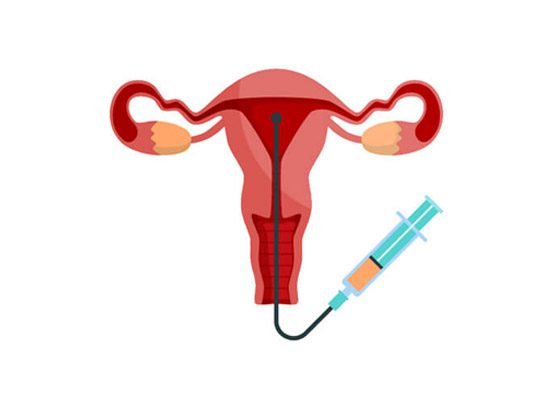Ovulation Induction with IUI

IUI stands for Intra Uterine Insemination. In simple words it means instilling the semen sample (after filtration) into the uterine cavity. So here the ovarian follicle is stimulated and ruptured in the same way but rather than have intercourse the couple come to the hospital and the male partner gives his semen sample which is then filtered or processed to remove the unwanted debris and unhealthy sperms after which this sample is instilled into the female partners uterus.
Success rates per menstrual cycle varies between 15-20%.
Patent tubes in the female partner are a must for these treatment modalities.
IUI is the preferred method of treatment in couples where the male partner’s semen is of intermediate quality ie, not very poor but not normal either.
This gives a higher success rate as the quantity and quality of sperms in the uterus at the time of ovulation is greater and better than that found during sexual intercourse.
Overview of the procedure
1. Ovulation Induction
The first step in ovulation induction with IUI is to stimulate ovulation using medications such as clomiphene citrate, gonadotropins, letrozole, or a combination of these medications. The goal is to produce one or more mature follicles in the ovaries.
2. Monitoring
During ovulation induction, the woman's menstrual cycle is monitored closely with blood tests and ultrasound scans to track the growth of the follicles and determine the optimal time for insemination.
3. Insemination
Once the follicles have reached the desired size, the woman undergoes a procedure called intrauterine insemination (IUI). This involves washing and concentrating the sperm to remove any impurities and then placing them directly into the uterus through a thin catheter.
4. Post-insemination care
After the IUI procedure, the woman is typically advised to rest for a short time before resuming normal activities. She may be prescribed progesterone supplements to support the development of the uterine lining.
5. Pregnancy test
About two weeks after the IUI procedure, the woman will undergo a pregnancy test to determine if the treatment was successful.
Frequently Asked Questions
How does ovulation induction with IUI work?
Ovulation induction with IUI involves using medication to stimulate the development and release of eggs from the ovaries, followed by the placement of washed and concentrated sperm directly into the uterus through a thin catheter.
What is the success rate of ovulation induction with IUI?
The success rate of ovulation induction with IUI varies depending on several factors, including the age of the woman, the cause of infertility, and the number of insemination cycles undergone. In general, the success rate ranges from 10% to 20% per cycle.
What are the risks of ovulation induction with IUI?
The risks of ovulation induction with IUI include multiple pregnancies, ovarian hyperstimulation syndrome (OHSS), and ectopic pregnancy. There is also a small risk of infection and bleeding during the procedure.
How long does the ovulation induction with IUI procedure take?
The ovulation induction with IUI procedure takes about 10 to 15 minutes to complete.
Is ovulation induction with IUI painful?
Ovulation induction with IUI is generally not painful. Some women may experience mild cramping or discomfort during the procedure.
How many cycles of ovulation induction with IUI are recommended?
The number of cycles of ovulation induction with IUI recommended depends on the individual case. In general, fertility specialists may recommend up to three to six cycles before considering other treatment options.
Need Experts Advice?
Discuss your fertility treatment options with our qualified fertility specialist to determine the best course of action for your individual case.

